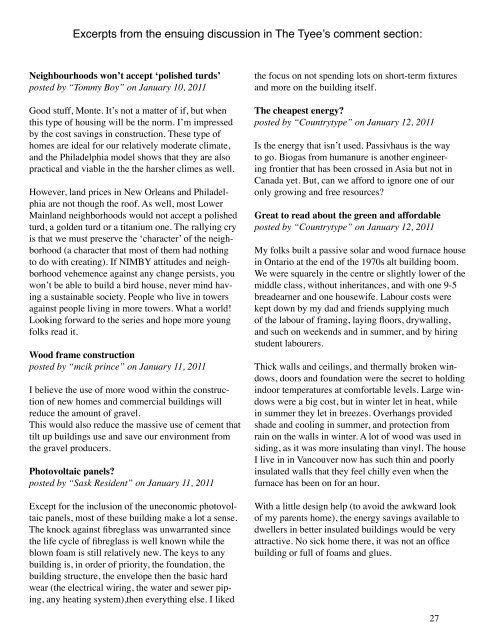from the ground up - The Tyee
from the ground up - The Tyee
from the ground up - The Tyee
You also want an ePaper? Increase the reach of your titles
YUMPU automatically turns print PDFs into web optimized ePapers that Google loves.
Excerpts <strong>from</strong> <strong>the</strong> ensuing discussion in <strong>The</strong> <strong>Tyee</strong>’s comment section:Neighbourhoods won’t accept ‘polished turds’posted by “Tommy Boy” on January 10, 2011Good stuff, Monte. It’s not a matter of if, but whenthis type of housing will be <strong>the</strong> norm. I’m impressedby <strong>the</strong> cost savings in construction. <strong>The</strong>se type ofhomes are ideal for our relatively moderate climate,and <strong>the</strong> Philadelphia model shows that <strong>the</strong>y are alsopractical and viable in <strong>the</strong> <strong>the</strong> harsher climes as well.However, land prices in New Orleans and Philadelphiaare not though <strong>the</strong> roof. As well, most LowerMainland neighborhoods would not accept a polishedturd, a golden turd or a titanium one. <strong>The</strong> rallying cryis that we must preserve <strong>the</strong> ‘character’ of <strong>the</strong> neighborhood(a character that most of <strong>the</strong>m had nothingto do with creating). If NIMBY attitudes and neighborhoodvehemence against any change persists, youwon’t be able to build a bird house, never mind havinga sustainable society. People who live in towersagainst people living in more towers. What a world!Looking forward to <strong>the</strong> series and hope more youngfolks read it.Wood frame constructionposted by “mcik prince” on January 11, 2011I believe <strong>the</strong> use of more wood within <strong>the</strong> constructionof new homes and commercial buildings willreduce <strong>the</strong> amount of gravel.This would also reduce <strong>the</strong> massive use of cement thattilt <strong>up</strong> buildings use and save our environment <strong>from</strong><strong>the</strong> gravel producers.Photovoltaic panels?posted by “Sask Resident” on January 11, 2011Except for <strong>the</strong> inclusion of <strong>the</strong> uneconomic photovoltaicpanels, most of <strong>the</strong>se building make a lot a sense.<strong>The</strong> knock against fibreglass was unwarranted since<strong>the</strong> life cycle of fibreglass is well known while <strong>the</strong>blown foam is still relatively new. <strong>The</strong> keys to anybuilding is, in order of priority, <strong>the</strong> foundation, <strong>the</strong>building structure, <strong>the</strong> envelope <strong>the</strong>n <strong>the</strong> basic hardwear (<strong>the</strong> electrical wiring, <strong>the</strong> water and sewer piping,any heating system),<strong>the</strong>n everything else. I liked<strong>the</strong> focus on not spending lots on short-term fixturesand more on <strong>the</strong> building itself.<strong>The</strong> cheapest energy?posted by “Countrytype” on January 12, 2011Is <strong>the</strong> energy that isn’t used. Passivhaus is <strong>the</strong> wayto go. Biogas <strong>from</strong> humanure is ano<strong>the</strong>r engineeringfrontier that has been crossed in Asia but not inCanada yet. But, can we afford to ignore one of ouronly growing and free resources?Great to read about <strong>the</strong> green and affordableposted by “Countrytype” on January 12, 2011My folks built a passive solar and wood furnace housein Ontario at <strong>the</strong> end of <strong>the</strong> 1970s alt building boom.We were squarely in <strong>the</strong> centre or slightly lower of <strong>the</strong>middle class, without inheritances, and with one 9-5breadearner and one housewife. Labour costs werekept down by my dad and friends s<strong>up</strong>plying muchof <strong>the</strong> labour of framing, laying floors, drywalling,and such on weekends and in summer, and by hiringstudent labourers.Thick walls and ceilings, and <strong>the</strong>rmally broken windows,doors and foundation were <strong>the</strong> secret to holdingindoor temperatures at comfortable levels. Large windowswere a big cost, but in winter let in heat, whilein summer <strong>the</strong>y let in breezes. Overhangs providedshade and cooling in summer, and protection <strong>from</strong>rain on <strong>the</strong> walls in winter. A lot of wood was used insiding, as it was more insulating than vinyl. <strong>The</strong> houseI live in in Vancouver now has such thin and poorlyinsulated walls that <strong>the</strong>y feel chilly even when <strong>the</strong>furnace has been on for an hour.With a little design help (to avoid <strong>the</strong> awkward lookof my parents home), <strong>the</strong> energy savings available todwellers in better insulated buildings would be veryattractive. No sick home <strong>the</strong>re, it was not an officebuilding or full of foams and glues.27








